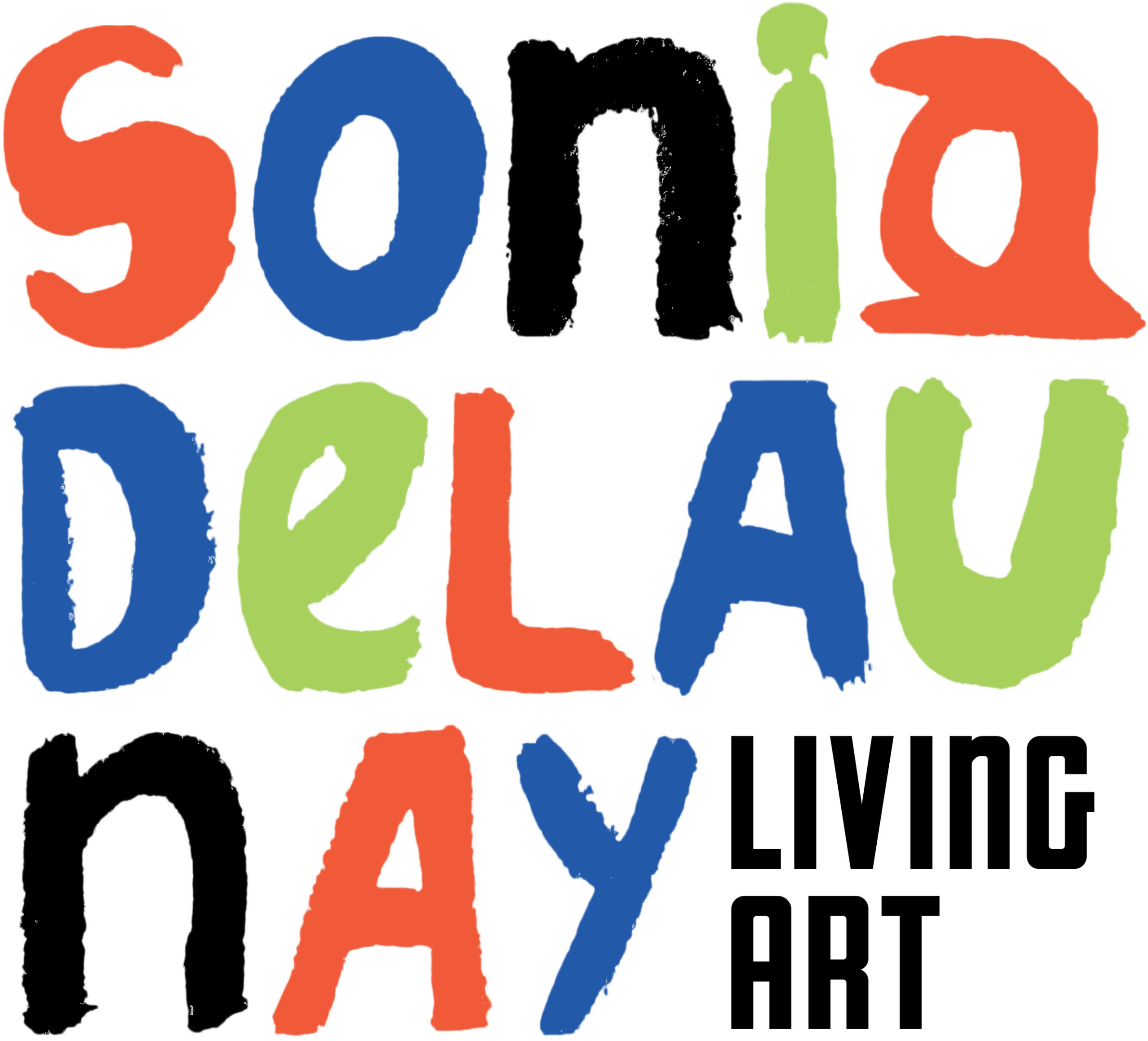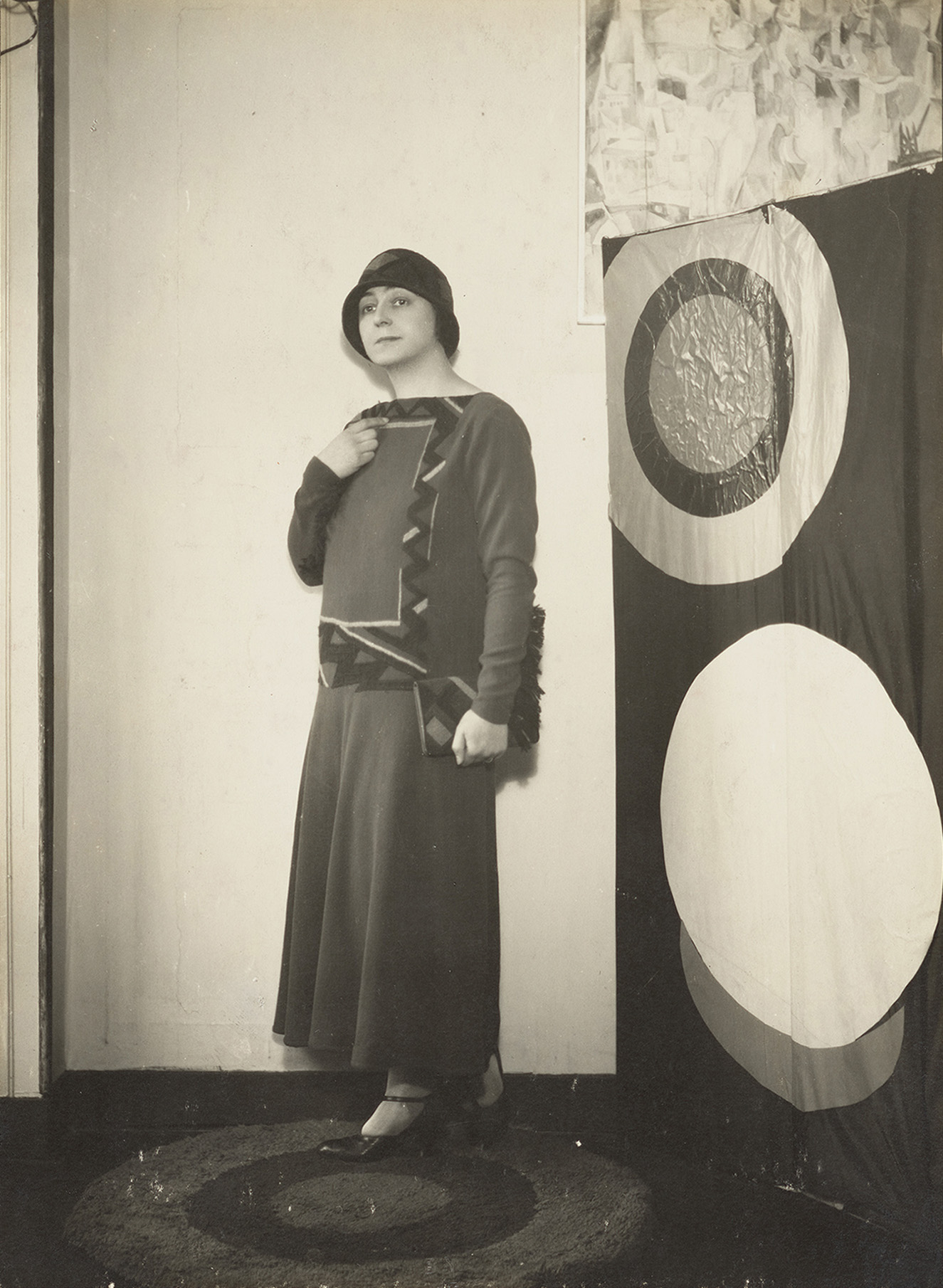THE ART OF SELF-FASHIONING
As an artist, designer, and businesswoman, Sonia Delaunay consciously constructed a personal brand through visual representations of herself and inventive graphic renderings of her name. She placed her own image at the center of artfully staged photographs of her work in interior and fashion design—most famously in her Simultaneous Dress (1913). Book covers, posters, pamphlets, and other promotional materials prominently feature the artist’s name printed in bright colors so as to appear hand-painted. From the start of her career, and like no one before her, she affirmed that it was not merely creativity and talent but her very being that gave life to her art. Sonia Delaunay: Prises de vues pour une monographie (Sonia Delaunay: Footage for a Monograph), a film directed by Patrick Raynaud (born 1946) and produced with her enthusiastic participation in 1972, shows how even in her final years, she made use of modern media to promote the simultaneity of art and self. As she boldly declares in the film, “I live color, I love it and I know it.”
THE ART OF SELF-FASHIONING
As an artist, designer, and businesswoman, Sonia Delaunay consciously constructed a personal brand through visual representations of herself and inventive graphic renderings of her name. She placed her own image at the center of artfully staged photographs of her work in interior and fashion design—most famously in her Simultaneous Dress (1913). Book covers, posters, pamphlets, and other promotional materials prominently feature the artist’s name printed in bright colors so as to appear hand-painted. From the start of her career, and like no one before her, she affirmed that it was not merely creativity and talent but her very being that gave life to her art. Sonia Delaunay: Prises de vues pour une monographie (Sonia Delaunay: Footage for a Monograph), a film directed by Patrick Raynaud (born 1946) and produced with her enthusiastic participation in 1972, shows how even in her final years, she made use of modern media to promote the simultaneity of art and self. As she boldly declares in the film, “I live color, I love it and I know it.”
As an artist, designer, and businesswoman, Sonia Delaunay consciously constructed a personal brand through visual representations of herself and inventive graphic renderings of her name. She placed her own image at the center of artfully staged photographs of her work in interior and fashion design—most famously in her Simultaneous Dress (1913). Book covers, posters, pamphlets, and other promotional materials prominently feature the artist’s name printed in bright colors so as to appear hand-painted. From the start of her career, and like no one before her, she affirmed that it was not merely creativity and talent but her very being that gave life to her art. Sonia Delaunay: Prises de vues pour une monographie (Sonia Delaunay: Footage for a Monograph), a film directed by Patrick Raynaud (born 1946) and produced with her enthusiastic participation in 1972, shows how even in her final years, she made use of modern media to promote the simultaneity of art and self. As she boldly declares in the film, “I live color, I love it and I know it.”
One of Sonia Delaunay’s foundational works, the Robe simultanée became an early symbol of her desire to merge art and life. She called it the “Simultaneous dress,” in reference to the practice of Simultanism, a term that she and Robert Delaunay coined to describe their personal contribution to pictorial abstraction. Sonia thus affirmed that she had created the garment according to color theory integral to modern painting—rather than according to principles of dressmaking. Indeed, the shapes and colors of the textile fragments eclipse the silhouette of the hand-sewn dress, in effect an abstract composition intended to envelop the artist’s own body. Delaunay famously donned the dress for lively soirées at the Salle Bullier dancehall in Paris, activating its bold colors and shapes through movement—and thereby transforming herself into a work of living art.
One of Sonia Delaunay’s foundational works, the Robe simultanée became an early symbol of her desire to merge art and life. She called it the “Simultaneous dress,” in reference to the practice of Simultanism, a term that she and Robert Delaunay coined to describe their personal contribution to pictorial abstraction. Sonia thus affirmed that she had created the garment according to color theory integral to modern painting—rather than according to principles of dressmaking. Indeed, the shapes and colors of the textile fragments eclipse the silhouette of the hand-sewn dress, in effect an abstract composition intended to envelop the artist’s own body. Delaunay famously donned the dress for lively soirées at the Salle Bullier dancehall in Paris, activating its bold colors and shapes through movement—and thereby transforming herself into a work of living art.
Drag to rotate dress
One of Sonia Delaunay’s foundational works, the Robe simultanée became an early symbol of her desire to merge art and life. She called it the “Simultaneous dress,” in reference to the practice of Simultanism, a term that she and Robert Delaunay coined to describe their personal contribution to pictorial abstraction. Sonia thus affirmed that she had created the garment according to color theory integral to modern painting—rather than according to principles of dressmaking. Indeed, the shapes and colors of the textile fragments eclipse the silhouette of the hand-sewn dress, in effect an abstract composition intended to envelop the artist’s own body. Delaunay famously donned the dress for lively soirées at the Salle Bullier dancehall in Paris, activating its bold colors and shapes through movement—and thereby transforming herself into a work of living art.
One of Sonia Delaunay’s foundational works, the Robe simultanée became an early symbol of her desire to merge art and life. She called it the “Simultaneous dress,” in reference to the practice of Simultanism, a term that she and Robert Delaunay coined to describe their personal contribution to pictorial abstraction. Sonia thus affirmed that she had created the garment according to color theory integral to modern painting—rather than according to principles of dressmaking. Indeed, the shapes and colors of the textile fragments eclipse the silhouette of the hand-sewn dress, in effect an abstract composition intended to envelop the artist’s own body. Delaunay famously donned the dress for lively soirées at the Salle Bullier dancehall in Paris, activating its bold colors and shapes through movement—and thereby transforming herself into a work of living art.
Drag to rotate dress
View dress details
1913
Patchwork of various textiles
Private collection
Photos: Bruce M. White
Sonia Delaunay and her husband, Robert, named their workshop “Ateliers Simultané” in 1913. This stationery was designed to give a brand identity to their art production. Though physically confined to Paris, the Delaunays imagined their studio’s commercial reach would extend across the world—as the annotations on the letterhead reveal.
Sonia Delaunay and her husband, Robert, named their workshop “Ateliers Simultané” in 1913. This stationery was designed to give a brand identity to their art production. Though physically confined to Paris, the Delaunays imagined their studio’s commercial reach would extend across the world—as the annotations on the letterhead reveal.
1913
Pochoir and colored pencil on paper
Bibliothèque nationale de France, Paris, gift of Sonia Delaunay, 1977
This self-portrait by Sonia Delaunay, used for the cover of her autobiography, is a later iteration of a self-portrait she created in 1916. Using the abstract forms and pure colors emblematic of her art, this rendering of her own face shows how she became part of her art—and it became part of her.
This self-portrait by Sonia Delaunay, used for the cover of her autobiography, is a later iteration of a self-portrait she created in 1916. Using the abstract forms and pure colors emblematic of her art, this rendering of her own face shows how she became part of her art—and it became part of her.
1978
Gouache and pencil on Arches wove paper
Galerie Zlotowski, Paris
Sonia Delaunay created this poster for her second solo show at Galerie Bing, Paris, in 1964. It is a variation on a design she first made for the cover of the 1938 edition of Propos d’atelier by art critic André Salmon (1881–1969). In this version, Delaunay placed her composition against a background of hatched strokes of colored pencil. Its final iteration—red, white, and black against a solid blue square—was used on posters, invitations, and a limited-edition lithograph series, in effect becoming an unofficial logo for the artist.
Sonia Delaunay created this poster for her second solo show at Galerie Bing, Paris, in 1964. It is a variation on a design she first made for the cover of the 1938 edition of Propos d’atelier by art critic André Salmon (1881–1969). In this version, Delaunay placed her composition against a background of hatched strokes of colored pencil. Its final iteration—red, white, and black against a solid blue square—was used on posters, invitations, and a limited-edition lithograph series, in effect becoming an unofficial logo for the artist.
1964
Gouache and colored pencil on paper
Bibliothèque nationale de France, Paris, gift of Sonia Delaunay, 1977
Sonia Delaunay used photography to construct her public persona and to visually unite different aspects of her artistic production. She was often pictured wearing her own creations and in her home or studio, surrounded by the paintings, furnishings, and fabrics that she designed and arranged into harmonious compositions.
Sonia Delaunay used photography to construct her public persona and to visually unite different aspects of her artistic production. She was often pictured wearing her own creations and in her home or studio, surrounded by the paintings, furnishings, and fabrics that she designed and arranged into harmonious compositions.















